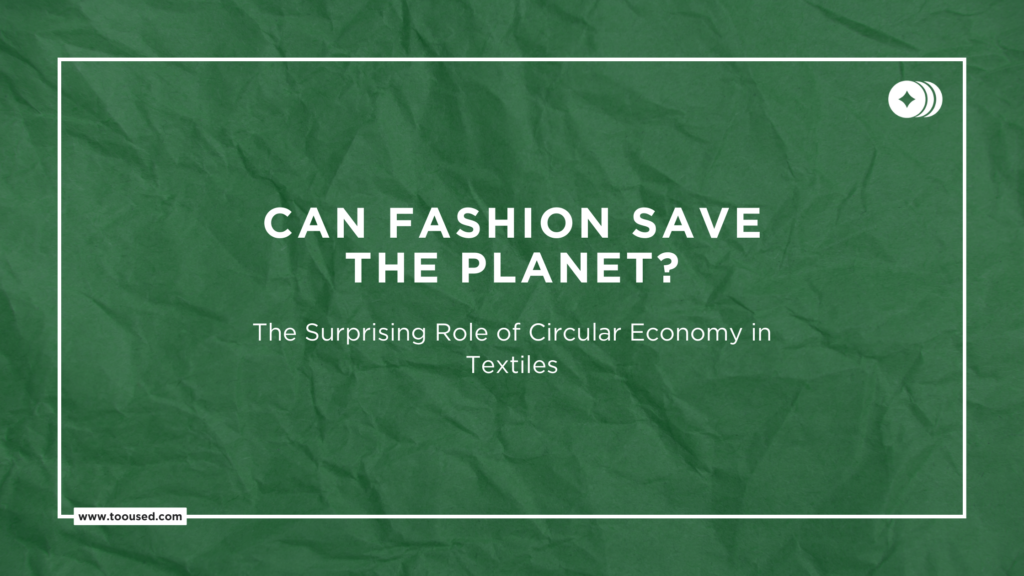Can Fashion Save the Planet? Role of Circular Economy in Textiles

Introduction
Have you ever thought about how your love for fashion could be key to saving our planet? The Circular Economy in Fashion is not just a trendy concept; it’s a necessary shift towards sustainability. This blog post delves into how adopting circular fashion models and textile recycling innovations can revolutionize our relationship with clothes.
The Rising Trend of Circular Economy in Fashion
The Circular Economy in Fashion is a transformative approach that re-imagines the lifecycle of clothing. It’s about moving away from the traditional ‘take-make-waste’ model and embracing a system where resources are reused and recycled. This shift is crucial to reducing the Environmental Impact of Fashion, which is currently one of the largest polluters globally.
Textile Recycling Innovations: A Game Changer
Textile Recycling Innovations are at the forefront of this revolution. Innovative technologies are now enabling us to turn old garments into new, reducing the need for virgin materials. Such Textile Recycling Innovations not only help in managing Textile Waste but also significantly cut down on environmental degradation.
The Role of Platforms in Selling Old Clothes Online
Platforms like TooUsed users to Sell Old Clothes Online are becoming increasingly popular. They are pivotal in Circular Fashion Models, allowing consumers to easily Sell Used Clothes Online. This not only helps in Textile Waste Management but also offers a way to Sell Old Clothes for Money, adding an economic incentive to sustainability.
Sell Used Clothes Online: A Step Towards Sustainability
Every time you Sell Used Clothes Online, you’re contributing to Circular Economy in Fashion. This simple act of choosing to Sell Old Clothes for Money rather than discarding them extends the life of clothing, reduces waste, and supports Textile Recycling Innovations.
Textile Waste Management: A Critical Aspect
Effective Textile Waste Management is essential in reducing the Environmental Impact of Fashion. By adopting Circular Fashion Models and supporting platforms that facilitate to Sell Old Clothes Online, we can significantly reduce the amount of textile waste that ends up in landfills.
The Environmental Impact of Fashion: A Global Concern
The Environmental Impact of Fashion is a growing concern. The industry is responsible for a significant portion of the world’s carbon emissions and water consumption. By embracing Circular Economy in Fashion and Textile Recycling Innovations, we can mitigate these environmental issues.
Recycling in Textile Industry: Towards a Greener Future
Recycling in the Textile Industry is a key component of Green Fashion Solutions. It involves reprocessing old clothing and textiles into new materials, thereby embodying the principles of the Circular Economy in Fashion.
Green Fashion Solutions: The Way Forward
Green Fashion Solutions, including Textile Recycling Innovations and Circular Fashion Models, are the future of sustainable fashion. They offer a pathway to mitigate the Environmental Impact of Fashion while providing opportunities to Sell Old Clothes for Money.
Clothing Recycling Programs: Bridging the Gap
Clothing Recycling Programs play a vital role in Circular Fashion Models. They provide a structured approach to Textile Waste Management, ensuring that garments are either reused or recycled.
Conclusion
Embracing the Circular Economy in Fashion is not just a choice; it’s a necessity for our planet’s future. By participating in initiatives like Textile Recycling Innovations, Selling Old Clothes Online, and supporting Clothing Recycling Programs, we make a significant contribution towards a more sustainable world.